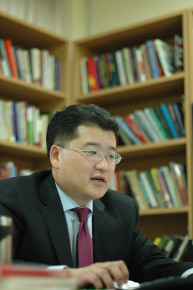Exploring the potential of an NEA integration
IMAGINE YOURSELF crossing the borders between South Korea, Japan and China freely without the long, tedious, and complicated process of checking visas, luggage, and the purposes of visits. This is actually becoming a reality in the Europe through the Schengen Agreement. Can North East Asia (NEA) ever achieve a similar level of integration such as the European model? The combination of the Japanese economy, Chinese market, Korean technology, and similar cultural backgrounds, the integration would certainly be an ideal possibility. But is it feasible at all? *The Yonsei Annals* will explore the potential.
Why NEA integration all of sudden?
The talks of the NEA integration have been conceptualized ever since the economy of the region played a significant role in the global market with increasing trade and investment between the three countries. Never before in modern history has China, Japan, and Korea been as closely linked economically as they are now. An indication of their growing economic interaction is the fact that, Japan has become China's third-largest trading partner. More specifically, “1997 Asian Financial Crisis was one factor that triggered the NEA integration. The risk of being separated and having different reactions to the financial crisis motivated the region to cooperate even closer,” said Cho Hong-sik (Prof., Dept. of Political Science, Soongsil Univ.).
If regional integration in NEA is made possible, the most obvious fact is that students can seek opportunities supra-nationally. Their competition and goals are no longer bound to one nation. True globalization of intellectual interaction can be achieved through the NEA integration. Educational interaction at the college level is already actively taking place. Yonsei Univ. has contracted with UC Berkeley to build the East Asian Education Base with UC Berkeley by 2010. Through this base, students around the region can come and interact cooperatively and competitively with Korean students. Once the region harmonizes, Korea will be an ideal setting as the educational hub of NEA. “Korean students should use their soft power or knowledge to play a leading role in the region,” said Kim Ki-jung (Prof., Political Science, Yonsei Univ.).
Positive perspectives
There are some bright prospects to move NEA toward a closer alliance.
The population movement between the three nations is taking place at a very vigorous level, which is a positive sign that the region is moving closer to each other through active network of human resources. “Population movement within the region is a proxy indicator of measuring a region’s connectivity, reflecting how a region is functionally integrated in terms of social openness towards each other. To each state in NEA, foreign visitors in the region constitute a substantially large portion, confirming a dense connectivity and interdependent network in the region,” said Choi Jong-kun (Prof., Univ. of North Korean Studies).
Also, NEA is already economically interdependent. The level of integration and mutual benefits from trade and investments are already higher than that of Europe in its initial stage of integration. Some argue that NEA’s economic integration has already happened naturally without necessarily adopting artificial multilateral mechanisms. In 2002, China accounted for 60.8% of the total exports of Japan and 92.4% after a year. The free flow of trade, capital, investments, and technology has promoted overall growth of NEA economies. “These motivated modernization of China, economic recuperation of Japan, market-restructuring of South Korea, and steady economic growth for all,” said Choi. The recent IMF study also presented that trade within Asia increased by 850%.

EU is different from the Asian model!
“People look at the EU as a prototype for the NEA integration but it is only one historical anomaly. We look at the EU and say, ‘we should make a regional integration, too’ just because the EU model was a successful one, not regarding the background differences,” said Choi. We should note that the fundamental backgrounds of the European integration and the NEA integration are different.
Historically, NEA is still an emotional battlefield whereas in Europe, Germany apologized repeatedly and made former subjugators not doubt their intentions. However, the issues of historically mis-worded school textbooks, the lack of a formal apology about comfort women during World War II, and continuous presidential visits to the Yasukuni shrine to pay tribute to Japanese war criminals are yet to be resolved. Therefore, a leadership or cooperative role from Japan is hardly expected in the near future. With the historical division between the regions and emotional discontent, any form of political policies for cooperation is bound to be blurred.
Also in terms of identity, NEA has a long way to go to amalgamate. “In the European model, co-existence and hybrid identical developments overcame nationalism,” said Kim. Jean Monnet, the founding father of the EU, had said, “I was born as a French but died as a European.” But in Asia, exclusive nationalism still prevails. Competition rather than cooperation is more common place. Although Europe is undergoing fundamental institutional change, with far-reaching efforts to redefine state prerogatives and a preference for multilateralism; Asia is characterized by marginal adjustments, insistence on state sovereignty and a preference for bilateralism.
The different impacts World War I and II had on the two separate regions can be held accountable too. In Europe, the United States actively built its alliance structure multi-nationally through NATO (North Atlantic Treaty of Organization). In Asia, by contrast, the United States forged a “hub and spoke” alliance, in which NEA relationships were connected bilaterally with the United States at the center. Security arrangements provided little basis for NEA to become more integrated. Even though there had been organizations to dialogue the security issue, they were conducted by scholars. Therefore, security cooperation was theory-based. Thus effort to find regional peace through realistic mechanisms is still lacking.
 | ||
| Prof. Choi Jong-kun | ||
Korea plays a dominant role
In the integration of NEA, Korea’s role is crucial. Japan’s obstinate stance on its historical issue and China’s fast emerging global power will make the neighboring countries only restless. Here, Korea’s task of leadership is necessary. Also, geographically, Korea is situated in the middle of the NEA region of Russia, China, and Japan, where there are large markets of natural resources. Korea is the bridge of NEA, connecting the continent and the ocean. Making Korea the hub of prosperity, peace, technological development, and education should be one goal.
The popularity of the Korean Wave is increasing rapidly. It is a good sign that Korean culture is being shared and enjoyed by the two other neighboring countries which had historically, economically, and in terms of security, been in rivalry with Korea. “Cultural dialogue is not only a means for spreading attraction but also a common ground to share perception and ideas. Exchange of cultural dialogue means communication and more importantly, mutual understanding,” said Kim.
Between China and Japan, Korea seems to be inferior in that its voice would not be considered substantially, but this position can actually be used as leverage. “While constraint and suspicion between the NEA countries are steadily increasing, Korea should cooperate with Southeast Asian nations [as well as NEA nations]. Through this cooperation, Korea can have more authority in the region,” said Cho.
Of course, Korea needs to resolve the nuclear issue with North Korea, which is also important. However, ironically, this conflict can be used as an opportunity. For the first time in history, Japan, China, and Korea are agreeing on one issue, which is the denuclearization of North Korea without using force. Using this as the common united front, mutual understanding among the region can be strengthened.
Lastly, one important factor to note is that Koreans are spread across the continent. There are Russian-Koreans, Chinese-Koreans, and Japanese-Koreans who have been living in those regions ever since they left their home country as refugees of war. It is important to provide these Koreans with appropriate Korean education and evoke nationalism so that they will become a crucial intellectual resource to Korea. With these latent human resources scattered throughout the region, Korea can spread its influence more stably. With much more increased cultural and intellectual interaction between these host countries and Korea; the nations will be able to assimilate with one another.
In a nutshell
The NEA community for regional security is ideal as three major economies of the world cooperate through interdependence of market mechanisms. However, we should note the fact that European experience is an exception, not a model. It is like looking at an Armani suit which was made for lengthy and well-built Westerners and wanting to wear it when it is not even suitable for our body. Integration should be tailor-made so we should not clothe ourselves the way Europe did. In this era, the NEA integration does seem tough due to lack of common ideologies, unlike EU where democracy was held firmly by all members. Using Korea as the educational and economic hub of NEA is one key to the integration process. In addition, Korea has a vast amount of scattered Koreans living throughout the NEA region who can be used as a crucial resource to influence the continental society and politics.
Box 1.
Process of European integration
After two major conflicts in the beginning of the 19th century, World War I and II, European states began to fear another potentially more intense war that would seriously shake the regional peace. Moreover, Soviet Union’s expanding communistic ideology that had been spreading throughout Central Europe added to the concerns of Western Europe and the United States. Thus, with the United States at the center, Europe found a way to search for cooperation not by means of war but by diplomatic means. The formation of Conference on Security and Cooperation in Europe (CSCE) enabled Europe to pursue common security through cooperation. With cooperative security pursuit crystallizing itself, economic and monetary integration also became a reality. The formation of European Coal and Steel Community (ECSC) contributed to the cooperation between formerly rival nations of Germany and France through active coal and steel trade. Now, the EU is a successful model for political, economic and social integration, even to the extent of eliminating the border check points.

